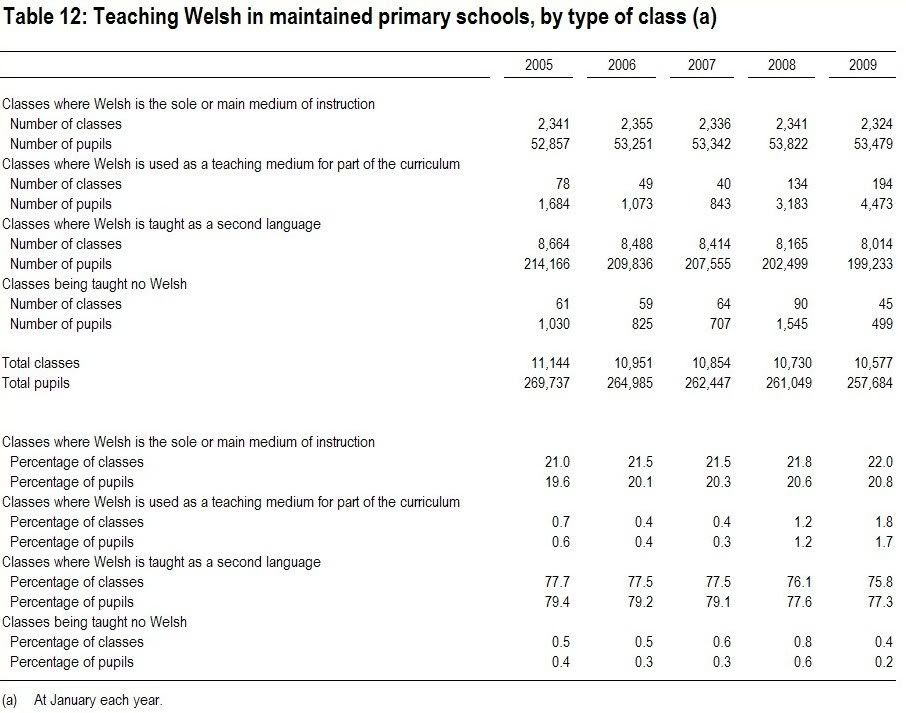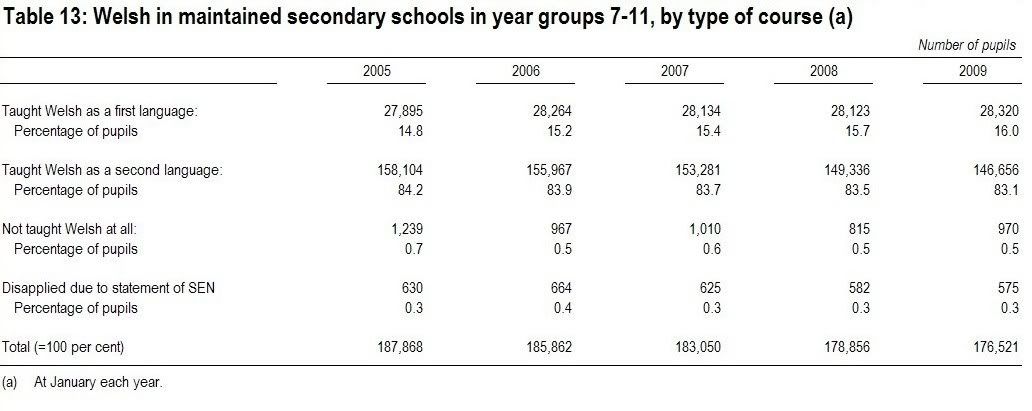The provisional Schools Census data for 2009 were released last week on the Welsh Government website. The full data will be released in October.
Year upon year, the numbers in Welsh-medium education have gone up, even against a background of a fall in overall pupil numbers. So it was a slight disappointment to find that the number in WM primary education had for the first time gone down, albeit slightly, from 53,822 to 53,479. However the overall number of pupils in primary schools has fallen sharply by 3,365 to 257,684 ... so the percentage in WM primary education continued its unbroken rise and now stands at 20.8%
However another interesting trend might be emerging. Namely the numbers of children being taught partly in Welsh (excluding Welsh lessons, obviously) has gone up quite markedly in the last two years. Last year the figure was 3,183 (1.2%) and this year it is 4,473 (1.7%).
As I've noted before, even though Welsh is a compulsory subject at all Key Stages, English-medium schools do not have a very good track record of producing pupils who can speak Welsh competently. So this rise reflects a welcome policy by some local authorities to increase the use of Welsh in other subjects and activities so as to reinforce what has been taught in the Welsh lessons. Only time will tell how successful this will be, but at least it is an attempt to come to terms with the problem. The vast majority of people in Wales want their children to be able to speak Welsh as well as English, so the answer is either to improve the way Welsh is taught in EM schools, or for them to switch to WM education.
Taking these two trends together means that the percentage of primary age children being taught Welsh to first language standard has risen from 20.2% in 2005 to 22.5% this year.
-
The secondary school figures are rather scant. There are no overall figures for those in WM secondary education. Indeed the distinction between WM and EM secondary schools is becoming less clear-cut with the emergence of a new range of classifications designed to reflect the percentage of subjects taught in Welsh rather than the overall ethos of the school ... but that's another matter.
What these figures show is that these is yet another increase in the numbers being taught Welsh to first language standards (i.e. those who would be expected to take a Welsh first language GCSE). The figure for school years 7-11 now stands at 28,320 (16.0%) up from 28,123 (15.7%) last year. In 2005 the figure was 14.8%.
-
What are we to make of this? Yes, of course we can and should take considerable satisfaction from the fact that the percentages keep on rising year upon year. Yet I must admit to feeling slightly disappointed that the figures aren't rising more quickly.
What do others think?




3 comments:
MH - I would say that while the figures seem to suggest that the overall numbers have reached a plateau - this may be due to the fact that in many areas there is a strong and increasing demand for WM education, but that education authorities are being slow to respond with provision of WM school places. The numbers will continue to rise, but will be limited by physical capacity. And that is a realtively easy fix.
The increase in WM pupils is frustratingly slow, and clearly while some councils are facilitating and encouraging the expansion of WM education, others are clearly doing whatever they can to slow it down. There should be increasing political pressure put on the WM "poor performers" (Blaenau Gwent, RCT, Bridgend, NPT, Carmarthenshire) to raise their game.
The development of Welsh in the EM sector is very interesting. With some political will other schools could be encouraged to follow the example of Treorci Comp, which teaches a quarter of its pupils partly through the medium of Welsh, and has them sitting Welsh GCSE in year 9.
You're right, these figures, despite appearing quite encouraging, don't bode well for Welsh as it needs to see far greater increases to help normalise the language.
I'm also more than a little concerned about the inbetween EM an WM schools which are developing. From my experience, English is such a strong language, that even in a dedicated Welsh-medium school, Welsh has difficulty holding its own. A person needs some 10,000 hours of speaking a language to become fluent in it. A person going through the education system will have spend some 3,000 hours in school if my maths are correct. The idea then that one can become fluent in both Welsh and English if you're from a non-Welsh speaking background (unless that pupil is especially dedicated) is iffy. To make up the hours to become fluent the pupil needs to play an active part in activities outside school where they can use the language. Welsh-medium schools try to provide for this, but it's less likely to happen in 'bilingual' schools. I'm therefore unsure how bilingual a person who goes to a 'bilingual' school is (unless they happen to also come from a Welsh-speaking home).
The fact is, only dedicated Welsh-medium schools have the track-record of creating an education and cultural system which can make pupils of all linguistic backgrounds, fluent in both Welsh and English. 'Bilingual' schools tend to confirm the ethnic-linguistic background of the child.
With very few exceptions, and despite hard work my teachers, 'bilingual' schools don't create bilingual pupils they perpetuate the linguisitc-ethnic background of the child ... which is one reason I believe some politicians and education authorities support them to the detriment of the proven track-record of WM schools.
Post a Comment